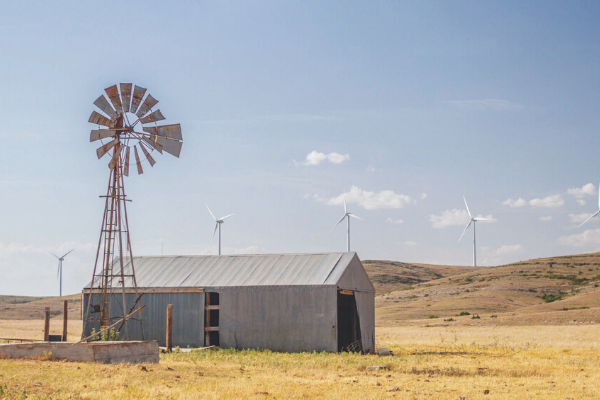OKLAHOMA CITY – Winds of change that are sweeping across America are blowing through Oklahoma, too.
In a report generated for the Legislature, the Oklahoma Corporation Commission declared that investment in wind generation has provided “significant economic development” in this state.
That has included approximately $14.7 billion spent to establish and grow the wind industry in Oklahoma, $23.5 million annually in state and local tax payments, $20 million to $30 million in annual land lease payments, and more than 7,000 jobs as of 2018, the commission wrote.
In 2010 the Legislature declared it to be in the public interest to promote the development of a robust transmission grid to expedite delivery of renewable energy, to improve reliability of the transmission system that delivers electricity to Oklahoma residents and businesses, and to promote development of wind energy in Oklahoma.
The Legislature also tasked the Corporation Commission (OCC) to collaborate with the Southwest Power Pool (SPP) to develop a plan to expand transmission capacity in Oklahoma and monitor construction of new transmission facilities.
$2.3B SPENT TO UPGRADE OKLAHOMA’S POWER GRID
Since 2010 the SPP has approved approximately $10 billion in upgrades to the electrical transmission grid, and approximately $2.3 billion of that was spent to improve the electricity grid in Oklahoma, the OCC report relates.
The Southwest Power Pool is a regional transmission organization that oversees grid operations across Oklahoma and parts or all of 13 other Great Plains states between the Red River and the U.S./ Canada border; besides Oklahoma, those states include Texas, New Mexico, Arkansas, Missouri, and Kansas.
The mission of the SPP is ensure the reliable supply of electricity, adequate power transmission infrastructure, and competitive wholesale electricity prices for a 546,000-square-mile region that includes more than 60,000 miles of high-voltage transmission lines.
Oklahoma is not a member of the SPP but several of its utilities are: Public Service Co. of Oklahoma (PSO), Oklahoma Gas & Electric Co., Western Farmers Electric Co-op, the Grand River Dam Authority, and the Oklahoma Municipal Power Authority.
OKLA. POWER COMPANIES FACE MANY CHALLENGES
Electric utilities in Oklahoma have typical maintenance problems but also operate in a region of the U.S. that requires them to cope with natural disasters. “We have basic maintenance costs, and then we have storms and fires, and floods and ice storms and tornadoes,” Corporation Commissioner Dana Murphy noted.
“Our utilities have done a great job of using automated metering systems and being able to restore power and become aware of outages quickly,” said Murphy, who assisted the commission staff in preparation of the power transmission report.
OUR STATE RANKS HIGH IN ELECTRICITY FROM WIND
In the latest annual ranking (2018), Oklahoma placed second in the nation in total wind generation, third for installed wind capacity and fourth in the number of installed wind turbines. Oklahoma’s wind generation provides enough electricity to power the equivalent of 2.6 million homes, the OCC reported.
To date, 44 wind energy facilities are operating in Oklahoma and 48 wind energy facilities have filed notices of intent to construct, the OCC reported.
For example, PSO, which serves a large swath of southwest Oklahoma, plans to add 675 megawatts of wind power to its portfolio. If the Corporation Commission gives its blessing, PSO will acquire a 45.5% ownership of three wind farms that will extend across parts of seven northwestern and north-central Oklahoma counties; those facilities reportedly will be operational by the end of 2021. PSO says it has approximately 3,800 megawatts of generating capacity.
Oklahoma reportedly had the fourth-lowest retail cost for electricity in the U.S. last year. “We have some of the lowest electricity costs in the nation,” Commissioner Murphy said.
WIND GENERATION EXCEEDED GOALS
The OCC’s 10-year summary shows development of wind energy surpassed what legislative and regulatory leaders at the time thought could be achieved.
Expectations a decade ago were that wind ultimately might be able to supply about 15% of the electricity Oklahomans routinely consumed, Murphy said. But industry officials recently said wind projects within the state supplied about 36% of the energy used by state residents and businesses in 2018 (the latest year for which data is available).
“We have far surpassed the goals we hoped for,” she said. In 2010 the state Legislature wanted to “grow renewables,” Murphy said. Consequently, “The power generation model has evolved over the past decade.”
Oklahoma is fortunate to be blessed with natural resources of oil, natural gas, and coal, as well as ample renewable sources of wind and solar energy, she said.
ACROSS U.S., WIND, SOLAR SURGE AS POWER SOURCES
Clean Economy Weekly newsletter claims wind and solar will dominate new power plants in 2020. Of the 42 gigawatts of new power plant capacity projected to go online nationwide – roughly the capacity in New York State – 76% will come from wind and solar, based on the latest data from the U.S. Energy Information Administration.
Earlier this month the EIA, the statistical arm of the U.S. Department of Energy, announced that Oklahoma and four other states will account for more than half of the planned wind capacity additions across the nation this year. Texas will account for 32% and Oklahoma comes in second at 6%; Wyoming, Colorado, and Missouri will account for 5% each.
New data from the Electric Reliability Council of Texas (ERCOT), the Lone Star state’s grid manager, show wind energy generated 20% of the electricity used in Texas last year, nearly edging out coal as the state’s second-leading source of power. ERCOT said wind’s share of generation increased from 18.5% percent in 2018.


